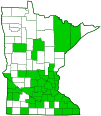black-and-gold bumble bee
(Bombus auricomus)
Conservation • Description • Habitat • Ecology • Distribution • Taxonomy
Conservation Status |
|
|||||||
| IUCN Red List | LC - Least Concern |
|||||||
| NatureServe | not listed |
|||||||
| Minnesota | not listed |
|||||||
Description |
||
Black-and-gold bumble bee is common, large, colonial bumble bee. It occurs in North America east of the Rocky mountains. It is common in southern Minnesota, less common in the north. It is one of the largest bumble bees in Minnesota. The female (worker) bee is 11 ⁄16″ to ¾″ (18 to 20 mm) long. The hairs on the head are mostly black. The top of the head (vertex) is densely pitted (punctate) in the middle and smooth at the sides, and there is a dense band of yellow hairs at the rear. There are two large compound eyes, one on each side of the head, and three small simple eyes (ocelli) in a triangular pattern at the top of the head between the compound eyes. The middle ocellus is larger than the the two lateral ones. The tops of the small (lateral) ocelli are distinctly below a virtual line (supraorbital line) with the top of the compound eyes. The antennae have 12 segments consisting of one basal segment (scape), one small connecting segment (pedicel), and ten more segments (flagellomeres). The scape is long, half as long as the all of the flagellomeres together. The first flagellomere is as long as the next two combined. The space below the compound eye (malar space) is smooth and shiny. The tongue is long. The thorax has three segments and is densely covered with relatively short hairs. The first segment is yellow, the second is black, and third is black with a very narrow yellow band at the rear. The abdomen has six segments and is densely covered with relatively short hairs. The first segment is black but may have some yellow hairs on the sides. The second and third segments are entirely yellow. Segments 4 through 6 are entirely black. Females are variable in color. Most are as described above. On light-colored individuals, the third thoracic segment is partially or entirely yellow, and the first abdominal segment has some yellow hairs on the sides or has yellow sides with some yellow hairs in the middle. The wings are dark brownish tinged at the base, lighter tinged approaching the tip. The legs are black. The queen is similar but larger. The male (drone) is similar but has 7 abdominal segments and 13 antennae segments. The thorax is yellow with a round black spot in the center. Abdominal segments 1 through 3 are yellow. The compound eyes are large. |
||
Size |
||
Male: ⅝″ to ¾″ (17 to 20 mm) Worker: 11 ⁄16″ to ¾″ (18 to 20 mm) Queen: ¾″ to 1″ (20 to 25 mm) |
||
Similar Species |
||
Habitat |
||
Grasslands, open areas |
||
Ecology |
||
Season |
||
May to September |
||
Behavior |
||
The colonies are small, usually having about 35 workers. |
||
Life Cycle |
||
The queen lays eggs individually in separate cells. |
||
Larva Food |
||
Larvae are fed both nectar for carbohydrates and pollen for protein. |
||
Adult Food |
||
Adults feed mostly on nectar but also on some pollen. |
||
Distribution |
||||
|
Sources |
|||
| 8/20/2023 | ||||
Occurrence |
||||
Common |
||||
Taxonomy |
|||
Order |
Hymenoptera (Ants, Bees, Wasps, and Sawflies) | ||
Suborder |
Apocrita (Narrow-waisted Wasps, Ants, and Bees) | ||
Infraorder |
Aculeata (Ants, Bees, and Stinging Wasps) | ||
Superfamily |
Apoidea (Bees and Apoid Wasps) | ||
| Epifamily | Anthophila (bees) | ||
Family |
Apidae (honey bees, bumble bees, and allies) | ||
Subfamily |
Apinae (honey, bumble, longhorn, orchid, and digger bees) | ||
Tribe |
Bombini | ||
Genus |
Bombus (bumble bees) | ||
| Subgenus | Bombias | ||
Some authors separate bumble bees and orchid bees into the subfamily Bombinae. NCBI follows this classification. Most authors follow Michener (2007) and include those groups in the subfamily Apinae with the honey bees. |
|||
Synonyms |
|||
|
|||
Common Names |
|||
black and gold bumble bee black-and-gold bumble bee |
|||
Glossary
Clypeus
On insects, a hardened plate on the face above the upper lip (labrum).
Malar space
In Hymenoptera, the space, equivalent to the cheek, between the bottom of the compound eye and the base of the mandible.
Ocellus
Simple eye; an eye with a single lens. Plural: ocelli.
vertex
The upper surface of an insect’s head.
Minnesota Bumble Bee Identification Guide
The University of MN Bee Lab has a free field identification guide to Minnesota bumble bees. It is indispensable for amateur naturalists or anyone wanting to identify the bumble bee in their photo. Click on the image below to download the guide.
Visitor Photos |
|||||
Share your photo of this insect. |
|||||
| This button not working for you? Simply email us at info@MinnesotaSeasons.com. Attach one or more photos and, if you like, a caption. |
|||||
MSorenson |
|||||
Landed on deck railing and appears to be working on something. |
|||||
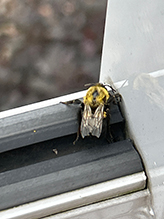 |
|||||
Clark O |
|||||
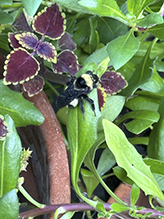 |
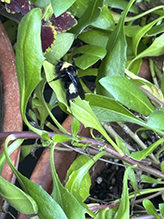 |
||||
Margot Avey |
|||||
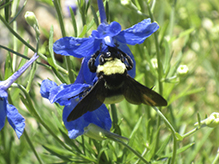 |
|||||
Alfredo Colon |
|||||
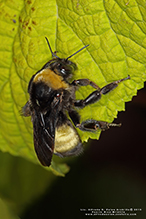 |
|||||
Gerry Garcia |
|||||
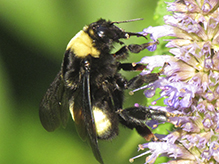 |
|||||
MinnesotaSeasons.com Photos |
|||||
|
|||||

Visitor Videos |
|||
Share your video of this mammal. |
|||
| This button not working for you? Simply email us at info@MinnesotaSeasons.com. Attach a video, a YouTube link, or a cloud storage link. |
|||
Other Videos |
|||
| B. auricomus Joseph Napper |
|||
About
Published on Jul 23, 2015 Black and gold bumble bee |
|||
| Bombus auricomus on Bee Balm 2018 margy stewart |
|||
About
Published on Jan 12, 2019 Here Black-and-Gold Bumble Bees find nectar in Bee Balm (Monarda fistulosa), one of the few species of wildflower to bloom during the drought summer of 2018. Bee Balm refused to bloom this year as it usually does in the upland native prairie, but it did bloom in our Creek Field, where we have a bottomland prairie restoration going on. B. auricomus likes prairie, so I was honored that they came to our prairie restoration! |
|||
| Bombus foraging returning to nest Karl Foord |
|||
About
Published on Mar 12, 2015 |
|||


Created: 8/20/2019
Last Updated:
